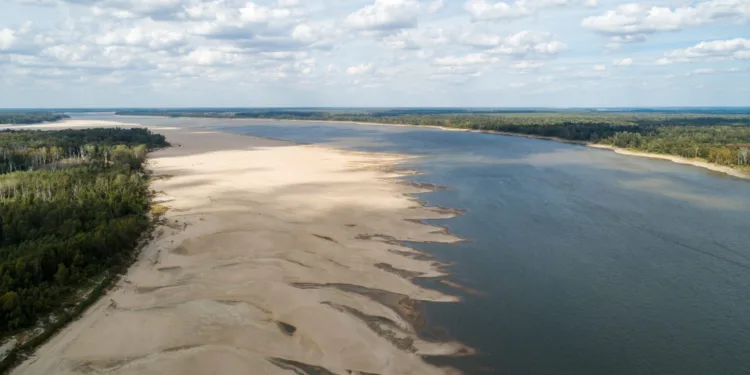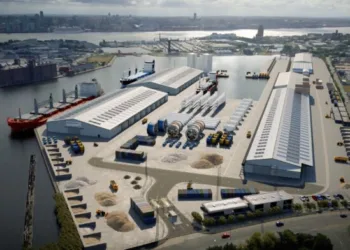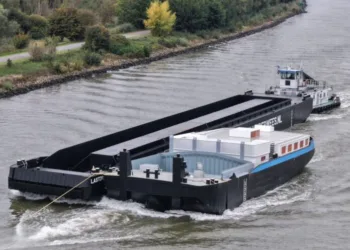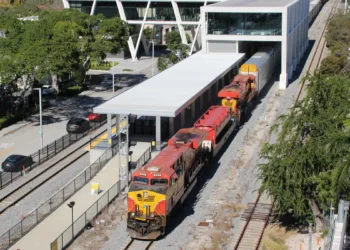A lack of rain, particularly in areas that drain into the Ohio River, is leading to restrictions on barge sizes on the Mississippi River
On September 13, water levels on the Mississippi at Memphis were measured at approximately minus 4.45 feet, according to data from the National Water Prediction Service, which is part of the National Oceanic and Atmospheric Administration (NOAA). The negative measurement is the difference between the actual level and a base number called the datum.
But with flows from upstream able to be predicted, NOAA is predicting that flows at Memphis were predicted to reach a “low threshold” of minus 8 feet on October 1.
Restrictions in place Friday
The low levels resulted in shipping restrictions being implemented Friday. According to a statement put out by the Coast Guard, the limitations between Cairo, Illinois, where the Ohio joins the Mississippi, limited barges to drafts of 10 feet and six barges wide. Those restrictions were put in place south to Lake Providence in Louisiana.
South of that to the Gulf of Mexico, the draft rises to 10’6″. The barge width remains the same at six barges across.
Donnie Williams is the chairman of the Lower Mississippi River Commission, an industry group that serves as a conduit between the river’s shipping companies and government agencies involved in keeping transit flowing, such as the Coast Guard and the Army Corps of Engineers. He is also a port captain with Canal Barge.
Williams said normal conditions on the lower Mississippi–which is generally defined as south of Cairo all the way down to the Gulf of Mexico–would allow a barge grouping to be eight barges wide and six barges long, for a total of 48.
Rising barge rates
The impact of the lower water levels may be showing up in barge rates. The Department of Agriculture’s weekly Grain Transportation Report is showing barge rates between Cairo, Illinois and Memphis as 27% less than last year’s figure and 20% less than the three-year average.
But the rate, expressed as a percentage of a 1976 base rate, ticked up as of Tuesday to 600, up from 584 a week earlier. On August 1, it was 401.
However, the barge rate quoted by the report for Tuesday would have been prior to the Coast Guard restrictions.
North of Cairo, the Mississippi has a series of locks and dams that can regulate low water levels. Additionally, the current Drought Monitor, published by a consortium of various educational and governmental agencies, shows drought conditions in the upper Midwest to be less severe than in the Ohio Valley. With those conditions reducing flows out of the Ohio River into the Mississippi at Cairo, adding to the difference in severity between the upper and lower Mississippi.
Soybean farmers taking another hit
Mike Steenhoek is executive director of the Soy Transportation Coalition (STC). The members the group serves are once again dealing with low water levels on top of the loss of the Chinese market as a result of the ongoing China-U.S. trade war.
He noted that the dry conditions in the Ohio Valley are a major contributor to the current woes.”If you have low volume water on the Ohio River, you have low volume of water on the lower Mississippi River,” Steenhoek said.
“Yes, it’s becoming a problem,” Steenhoek added. But it has not gotten to the level of last year, he said, which he described as “really traumatic.”
The low water levels are bringing about a “here we go again” reaction among other members of the river’s shipping community, including Williams.
“Four years ago, we reached historical lows, the lowest the Mississippi River had ever been,” Williams said. The feeling in the industry, he added, was that it was the result of a 100-year drought and “maybe this won’t happen again.”
But the river set new all-time low levels in 2022 and 2023, Williams said. And while the current levels are not those lows, “we’re hoping and praying we don’t set another record this year.”
More articles by John Kingston
XPO’s rating at Moody’s held steady but outlook is now ‘positive’
TQL opponent in broker liability SCOTUS case: let it ‘percolate’
TIA warns: TQL-linked broker liability case threatens industry
The post Shipping challenges on the rain-starved Mississippi…again appeared first on FreightWaves.



















